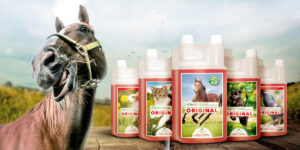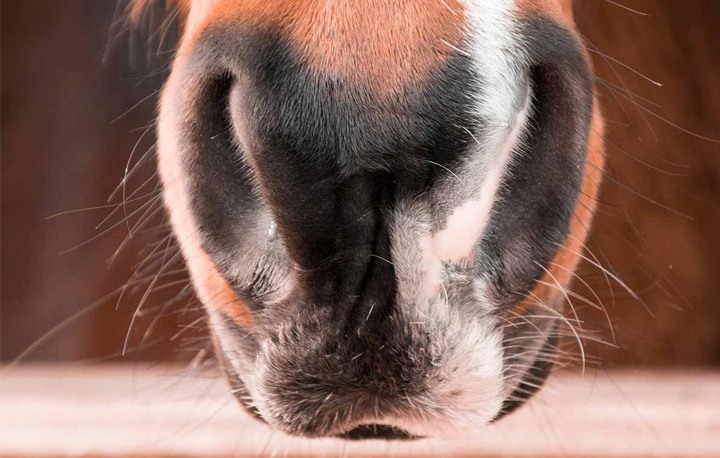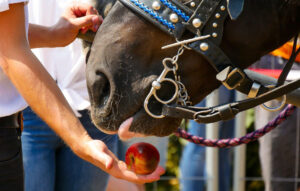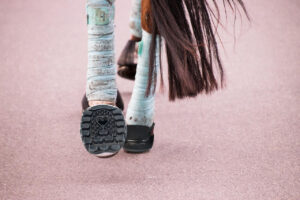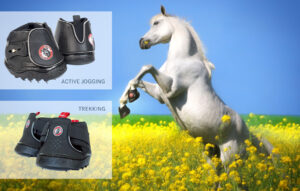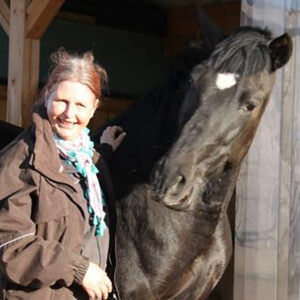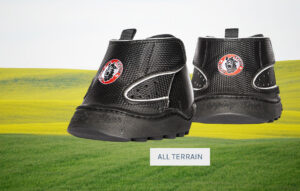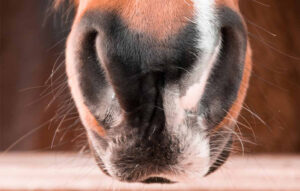In this article, we look at treating strangles in horses, as well as the causes, effects, symptoms and cures for horses suffering from strangles. We look at what you need to do if the disease breaks out in the stable, and we recommend some simple and effective remedies to help your horse get back on its feet.
Strangles
Equine strangles, also called adenitis equorum or coryza contagiosa equorum, is a worldwide infectious disease of the upper respiratory tract in horses. It is caused by the bacterium Streptococcus equi ssp. equi, is highly contagious, and occurs by droplet infection. Young animals, yearlings and weanlings are highly susceptible to the pathogen. Older horses with poor immune systems are also susceptible. Stables with frequent changes of horses are more at risk. The development of immunity of already once ill animals is possible. There is no obligation to report the disease. There is no transmission of the infection to humans.
Possible causes
Strangles can affect horses of any age. The bacteria settle in the lymph nodes. Infection among themselves occurs through the area of the nose and mouth.
Transmission can occur through anyone who has had contact with the diseased animal. Transmission can occur through clothing and shoes, hands, and objects of all kinds such as bridles, waterers, feed troughs. The causative agent of druse can persist in the horse’s environment for up to 6 weeks. Outside the stable, it lasts only a few days.
The excretion of pathogens does not end when the disease is over (symptom-free). Bacteria are excreted with the nasal secretions for up to three weeks after the end of clinical symptoms.
In individual cases, excretion can also last 36 months or longer. Two forms can be distinguished here. In cold druse, abscesses are located in the lymph nodes of the throat, air sac, or sinuses. You can spread the disease without having fever or nasal discharge.
The permanent excretor was infected and is recovered. After infection, the pathogens have retreated into the sinuses or air sacs and are shed again at irregular intervals. Other horses can always be re-infected. Irrigation of the air sacs and examination of the irrigation fluid in the laboratory or endoscopic examination of the air sacs may be able to detect the pathogen.
The incubation period of druse in horses is up to 14 days. Already a short time after infection, the disease can be transmitted without showing any symptoms of the disease.
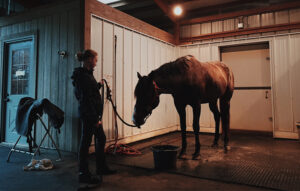
The typical symptoms
In affected horses, strangles is associated with sometimes severe pain in the area of the affected, enlarged lymph nodes and often appears with the following symptoms:
Leading symptom: Inflammation of the throat with suppuration and swelling of the lymph nodes in the head area, throat and lower jaw.
- Discharge from the nose (greenish-yellow, purulent and mucous).
- High fever of up to 41.5 degrees
- Fatigue
- Loss of appetite
- Head held low and neck stretched to relieve airway constricted by swelling
- Cough
- Possibly additional pneumonia if the bacteria pass into the lungs
After about 8 to 10 days, pus forms in the lymph nodes. Abscesses form, which can empty outward, which is a significant relief for the horse. The pus that escapes contains very high numbers of the pathogen and poses a high risk of infecting other horses if it comes into contact and spreads.
Possible complications
Metastatic stangles:
In some cases, the pathogen may infect internal organs such as the chest or abdominal cavity and the horse’s brain. In extreme cases, this dreaded complication can even lead to the death of the diseased animal.
Another rare and severe form of the disease is a reaction of the immune complex, the blood spot disease or petechial fever (Morbus maculosus, Purpura haemorrhagica). There is an inflammation of the blood vessels based on an excessive reaction from the immune system. The small blood vessels become inflamed and permeable to blood plasma. Swelling of the head and legs occurs. As the disease progresses, red blood cells may also leak. Petechiae form on the body. These are a large number of pinhead-sized bleedings on the body. In the worst case, this can lead to bleeding to death.
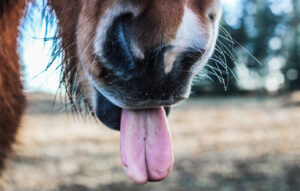
Inflammation of the nerve pathways around the throat can lead to a reduction or loss of the ability to swallow or affect the function of the larynx.
Airway constriction:
Another possible complication in the course of the disease is the severe enlargement of the pus-filled lymph nodes in the head area. The airways can be narrowed by the swelling, and the horses become short of breath. This can become life threatening. In this situation, the attending veterinarian must make the decision to perform a tracheotomy to prevent it from suffocating.
The diagnostic pathways
If druse is suspected, the veterinarian must be notified immediately. The veterinarian will take swabs from the deep nose and throat and send the material to the laboratory for clarification. In addition, a sample of the pus can confirm the diagnosis of druse.
A blood test for antibodies in the blood can provide further clarity. The detection of these specific antibodies is possible at the earliest two weeks after an infection with druse.
During inflammation, the number of white blood cells (leukocytes) in the blood increases. Also in the case of druse.
Treatment
Treatment is carried out by the veterinarian. In many cases, the drug of choice is penicillin. The treatment is individual and is adapted to the severity of the disease.
Echinacea, homeopathy, Schuessler salts and acupressure can be used to support the treatment.
Soft abscesses of the lymph nodes in which pus has accumulated can be opened and flushed by the veterinarian. Flushing out the affected air sacs when pus has accumulated can bring good results and is performed daily to several times a week according to the advice of the treating veterinarian.
The sick horse must be spared and given rest in the stable or box.
Switch to soft feed:
Due to the narrowed airways, swallowing is often difficult. Soft warm feed is very pleasant for the horses.
Infrared radiation and ointments:
Maturation of the abscess can be accelerated with infrared radiation of the affected region. Warming ointments, warm compresses of comfrey or potatoes can additionally promote the maturation and drainage of the abscess.
Careful mucking out:
Contagious diseases spread quickly. Direct contact with other horses must be prevented. In front of the horse’s box or stable should be available disinfectant to disinfect hands and clothing and objects. For the feet, a tub with disinfectant. Daily mucking out and cleaning of the box is important. Wear disposable gloves. Use all utensils for mucking out separately for sick horses and disinfect continuously. Dogs and cats can also spread the disease.
Recovery prospects and prognosis
The prospects of curing druse in horses is basically good if therapy is started promptly.
Is it possible to prevent?
Keep new horses separated from other horses for a while. Have symptoms such as fever, yellowish nasal discharge, swollen lymph nodes clarified by a veterinarian. The risk of infection is very high with druse.
Older horses and horses with a poorer immune system require special observation. The best prophylaxis is a good immune system. Hygiene in the stable, species-appropriate feeding and husbandry with plenty of exercise in fresh air and vitamins support the immune system.
What to do in case of druse in horses?
All horses in the stable are at risk and the stable is quarantined until no more druse can be detected in the stable. And this can take weeks or months. No horse is allowed to leave the barn and no new horse is allowed in the barn. The herd will be closed.
The sick horses are separated from the healthy ones. It is best to create three areas in the stable / yard for healthy, sick and suspect horses. The care in the different areas should be done by different people. There should be no contact with other horses. Do not visit other stables. This could be how the virus is transmitted. Disinfection is extremely important. Also disinfect the shoes and clothes.
Fortifying the whole organism
Probably the simplest measure to ensure that your horse does not get sick is to fortify the horse, naturally. Our animals need good nerves and composure when dealing with us and the environment. But also in sports, competitions or at shows, calmness and composure paired with power, strength, energy and self-confidence bring great success.
Vita pro is a completely natural, liquid supplementary feed from nature’s treasure chest of valuable ingredients, developed for horses, dogs, cats and other animals, to provide a healthy and powerful portion of extra energy. However, Vita pro can do much more.
Vita pro has been used by dog, cat and horse owners for many years to support and improve the overall wellbeing of their animals and pets. Vita pro has been used for many years and has become a tried and trusted companion for horse owners and stable hands. Horses need daily good feed, fresh water, a clean stable with good air, plenty of light and exercise, as well as appropriate training and, if possible, a sensible supplementary feed.
Have your horse start the day full of zest for life, with Vita Pro
